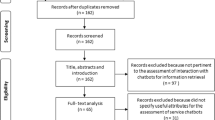Abstract
The paper deals with credible and relevantinformation flow in dialogs: How useful is it for areceiver to get some information, how useful is it fora sender to give this information, and how much credibleinformation can we expect to flow between sender andreceiver? What is the relation between semantics andpragmatics? These Gricean questions will be addressedfrom a decision and game-theoretical point of view.
Similar content being viewed by others
References
Asher, N., Sher, I., and Williams, M., 2001, “Game theoretical foundations for Gricean constraints,” pp. 31–36 in Proceedings 13th Amsterdam Colloquium, R. van Rooy and M. Stokhof, eds., Amsterdam: ILLC.
Aumann, R., 1990, “Nash equilibria are not self-enforcing,” pp. 201–206 in Economic Decision-Making: Games, Econometrics and Optimization, J. Gabszewicz et al., eds., Amsterdam: Elsevier.
Baltag, A., Moss, L., and Solecki, S., 1998, “The logic of public announcements and common knowledge,” pp. 43–56 in TARK 98, I. Gilboa, ed., San Francisco, CA: Morgan Kaufmann Publishers.
Bassan, B., Gossner, O., Scarsini, M., and Zamir, S., “Positive value of information in games,” manuscript.
Blume, A., DeJong, D., Kim, Y., and Sprinkle, G., 2001, “Evolution of communication with partial common interest,” Games and Economical Behavior 37, 79–120.
Clark, H., 1996, Using Language, Cambridge: Cambridge University Press.
Crawford, V. and Sobel, J., 1982, “Strategic information transmission,” Econometrica 50, 1431–1451.
Fagin, R., Halpern, J., Moses, Y., and Vardi, M., 1995, Reasoning about Knowledge, Cambridge, MA: MIT Press.
Farrell, J., 1988, “Communication, coordination and Nash equilibrium,” Economic Letters 27, 209–214.
Farrell, J., 1993, “Meaning and credibility in cheap-talk games,” Games and Economic Behavior 5, 514–531.
Farrell, J. and Rabin, M., 1996, “Cheap talk,” Journal of Economic Perspectives 10, 103–118.
Geanakoplos, J., 1994, “Common knowledge,” pp. 1438–1496 in Handbook of Game Theory, R. Aumann and S. Hart, eds., Amsterdam: Elsevier.
Gerbrandy, J. and Groeneveld, W., 1997, “Reasoning about information change,” Journal of Logic, Language, and Information 6, 147–196.
Gibbons, R., 1992, A primer in Game Theory, New York: Harvester Wheatsheaf.
Good, I.J., 1974, “A little learning can be dangerous,” British Journal for the Philosophy of Science 25, 340–342.
Grice, H.P., 1957, “Meaning,” Philosophical Review 66, 377–388.
Grice, H.P., 1967, “Logic and conversation,” typescript, pp. 22–40 in P. Grice, 1989, Studies in the Way of Worlds, Cambridge, MA: Harvard University Press.
Groenendijk, J. and Stokhof, M., 1984, “Studies in the semantics of questions and the pragmatics of answers,” Ph.D. Thesis, University of Amsterdam.
Hirshleifer, J. and Riley, J.G., 1992, The Analytics of Uncertainty and Information, Cambridge: Cambridge University Press.
Kooi, B., 2003, “Probabilistic dynamic epistemic logic,” Journal of Language, Logic and Information 12, 381–408.
Lewis, D., 1969, Convention, Cambridge, MA: Harvard University Press.
Luce, R.D. and Raiffa, H., 1957, Games and Decision, New York: John Wiley.
Merin, A., 1999, “Information, relevance, and social decisionmaking,” pp. 179–221 in Logic, Language, and Computation, Vol. 2, L. Moss et al., eds., Stanford, CA: CSLI.
Myerson, R., 1989, “Credible negotiation statements and coherent plans,” Journal of Economic Theory 48, 264–303.
Neyman, A., 1991, “The positive value of information,” Games and Economic Behavior 3, 350–355.
Osborne, M.J. and A. Rubinstein, A., 1994, A Course in Game Theory, Cambridge, MA: MIT Press.
Parikh, P., 1991, “Communication and strategic inference,” Linguistics and Philosophy 14, 473–513.
Parikh, P., 2001, The Use of Language, Stanford, CA: CSLI Publications.
Parikh, R., 1994, “Vagueness and utility: The semantics of common nouns,” Linguistics and Philosophy 17, 521–535.
Parikh, R. and Ramanujam, R., 2003, “A knowledge based semantics of messages,” Journal of Logic, Language and Information 12, 453–467.
Rabin, M., 1990, “Communication between rational agents,” Journal of Economic Theory 51, 144–170.
Raiffa, H. and Schlaifer, R., 1961, Applied Statistical Decision Theory, Cambridge, MA: MIT Press.
Savage, L.J., 1954, The Foundations of Statistics, New York: Wiley.
Shannon, C., 1948, “The mathematical theory of communication,” Bell System Technical Journal 27, 379–423 and 623–656.
Szaniawski, K., 1967, “The value of perfect information,” Synthese 17, 408–424.
van Benthem, J., 2003, “Conditional probability meets update logic,” Journal of Language, Logic and Information 12, 409–421.
van Rooy, R., 2003, “Questioning to resolve decision problems,” Linguistics and Philosophy, to appear.
van Rooy, R., “Signaling games select Horn strategies,” Linguistics and Philosophy, in press.
van Rooy, R., “Utility, informativity and protocols,” Journal of Philosophical Logic, to appear.
Wald, A., 1950, Statistical Decision Functions, New York: John Wiley.
Watson, J., 1996, “Information transmission when the informed party is confused,” Games and Economical Behavior 12, 143–161.
Author information
Authors and Affiliations
Rights and permissions
About this article
Cite this article
van Rooy, R. Quality and Quantity of Information Exchange. Journal of Logic, Language and Information 12, 423–451 (2003). https://doi.org/10.1023/A:1025054901745
Issue Date:
DOI: https://doi.org/10.1023/A:1025054901745




